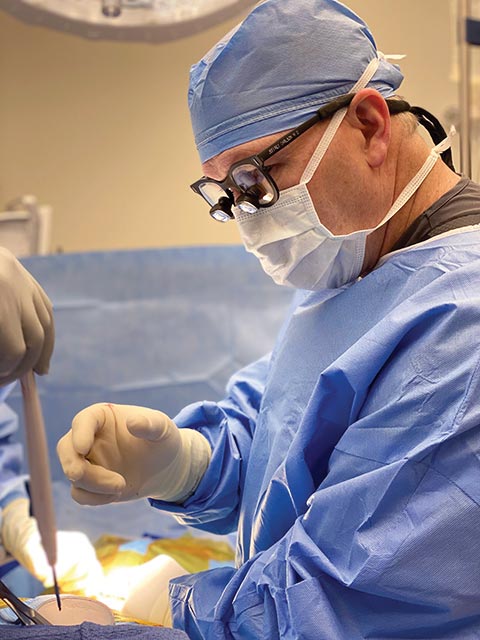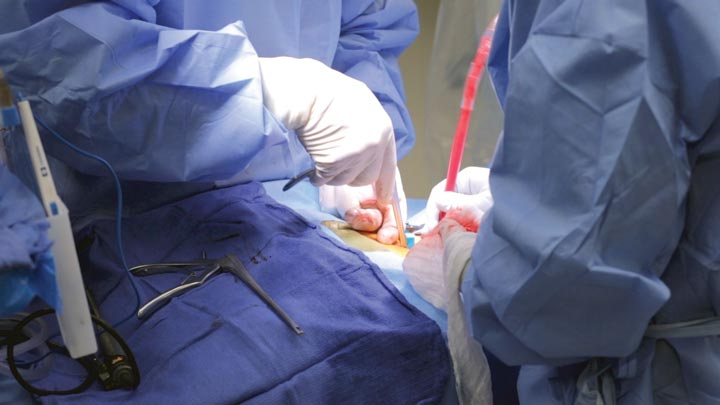- Home
- Article
The Boom Continues!
By: Adam Taylor | Managing Editor
Published: 2/20/2025
The volume of outpatient spine procedures has increased massively over the last 15 years — and there’s no end in sight.
Not so long ago, almost all spine patients underwent open surgery that included a large incision followed by several days of bedrest in a hospital.
The advent of minimally invasive surgical techniques and other advances kicked off a transformational shift about 15 years ago, as numerous spine procedures began to migrate from hospital inpatient ORs to HOPDs and ASCs. Same-day surgical facilities performed 193% more of them from 2010 to 2021, according to a study published last year in the North American Spine Surgery Journal. During that time, ASCs went from performing 12 types of spine surgeries to 58 different procedures, says the study. The growth has continued since. VMG Health’s ASCs in 2023: A Year in Review noted that outpatient surgery was up overall, and that spine procedures, particularly high-acuity cases, were an integral part of the uptick.
Zooming in
Last year, Orthopaedic & Spine Center (OSC) in Newport News, Va., performed more than 2,400 surgeries overall, 615 of which were outpatient spine surgeries at the nearby freestanding Coastal Virginia Surgery Center. That marked an expansion for the practice’s outpatient spine service line, which Harvard-trained Jeffrey R. Carlson, MD, MBA, CPE, FAAOS, expects to continue this year.
“With state-of-the-art minimally invasive techniques and advanced surgical technology, OSC has been able to offer many patients the opportunity to undergo spine surgeries and return home that day. This groundbreaking approach not only reduces recovery times but also decreases hospital stays, lowers costs and enhances patient comfort,” says Dr. Carlson, OSC’s president and managing partner. “Same-day spine surgery is transforming the way patients experience spinal care by minimizing downtime and accelerating recovery, allowing individuals to get back to their daily lives faster than ever before.”
All-systemic improvements

Just as the quantum leap from open to minimally invasive surgery (MIS) spurred the initial shift of cases from inpatient to outpatient ORs, MIS innovations will help the transfers continue.
“I think the whole concept of ‘minimally invasive’ is sometimes misconstrued,” says Dr. Carlson. “It’s not just a smaller skin incision, it’s what we’re doing while we’re inside.”
Recent advances allow surgeons to make one incision instead of four or six. The technique involves less stripping of the bone, better maintains bone quality and allows for more blood to flow to the bone, which causes less pain and enhances healing. “We can now put in all the needed hardware and do all the disc work and decompression through one incision,” explains Dr. Carlson. “Fewer incisions mean less iatrogenic problems for the patient. We’re still taking off soft tissue when we need to, but not excessively. This is a much better version of MIS because it doesn’t invade the body as much.”
This approach has allowed OSC to offer more lumbar and cervical spine fusions at its surgery center. The smaller incisions mean minimal exposure for the patient, while taking pressure off the spinal cord and the nerve roots without stripping the whole front of the spine. It ensures a good remaining blood supply, which increases the ability for fusion. Less decorticated or injured bone and soft tissue equates to a lower chance of infection. The decreased iatrogenic dysfunction in the muscles and tendons in the spine means less pain for patients, which means they can get up and become active sooner than ever before.
Anesthesia techniques have kept pace with the surgical advancements, says Dr. Carlson. Patients’ backs are now numbed with medications and injections, so there is a decreased use of inhaled anesthetics, which can cause postoperative nausea and vomiting as well as urinary retention, two conditions that can lead to delayed discharges or even a night in a hospital.
“Those complications are minimized by doing some local injections that decrease the amount of inhaled anesthetic that they get during the procedure,” says Dr. Carlson. “That increases the likelihood of the patient going home safely sooner.”
The anesthesia team at OSC makes sure to numb the skin incision in addition to injecting around the transverse processes and performing a field block around the muscles in the back. “We’re finding more and more that the skin incision is more sensitive than the deeper soft tissues,” he notes. “If you don’t numb the skin, the patients tend to have more pain.”
Higher-acuity cases
Surgeons have every reason to invest in outpatient spine, as reimbursements for inpatient procedures have steadily declined for years. Taking more high-risk cases to ASCs makes financial sense, as it could be the primary driver of increased caseloads. Dr. Carlson performed one of the first three-level lumbar fusions at an ASC in the country in March 2021 at his Coastal Virgina surgery center. The patient was a 37-year-old former semi-professional baseball player. He also implanted a spinal cord simulator into a 62-year-old woman around the same time.
OSC plans to add additional procedures to its roster in 2025 that include a wide range of decompression and fusion surgeries. Advanced surgical techniques have a lot to do with that, and many are the result of partnerships with more than 30 device companies and research institutions that have spurred innovations.
The practice is conducting research on bone grafting that shows some new bone putties and demineralized bone seem to produce faster fusions. The new grafting techniques promise to speed up healing and get patients back to their lifestyles sooner. It has also developed a smaller cage that provides the requisite support, while promoting quicker bone grafts.
Meanwhile, new pedicle screws are being developed, as are techniques to place them, that require less bone removal. The clinic is experimenting with new wound-care technologies as well. Dr. Carlson thinks virtual reality systems will be a bigger player in the outpatient spine space than robotic consoles because they don’t take up as much space and are less expensive.
New surgeon, anesthesiologist states of mind

When Dr. Carlson travels the country to educate surgeons about outpatient spine, he’s often surprised how some of his colleagues aren’t aware that his surgical approach was even a possibility. Some still perform anterior cervical procedures as inpatient procedures, the opposite of the norm. Whether the surgeons become amenable to the shift will be one of the biggest drivers to continued expansion.
“We became physicians so we can innovate and make patient care better,” says Dr. Carlson. “My hope is that once there’s a greater awareness of the options available to use, we’ll take advantage of it. Making a real impact on people’s lives and getting them back to doing what they want to do in their lives really makes you feel good as a surgeon.”
Dr. Carlson suggests that hesitant surgeons start small by performing single-level surgeries on young, healthy patients in an HOPD. “After that, they’ll feel more safe and secure to start doing them at a surgery center,” he says. “As they get more confident and comfortable, their practice will grow as they allow patients to recover at home, sleeping in their own bed and eating their own food.”
Anesthesiologist and patient education is another crucial component. “Once the anesthesia team gets more facile at their technique, they figure out that less anesthetic and inhaled anesthesia in the outpatient arena is better for the patients,” he says. “Too much is a big issue during long surgeries and could result in blood clots, pneumonias or other complications.”
While some patients still need to be educated about the existence, safety and benefits of outpatient spine procedures, many are already on board, which is a direct result of people not wanting to be in the hospital during the height of COVID-19.
“One thing we explain is that they’re not sick. They’re healthy people with a back or a neck problem,” says Dr. Carlson. “They need to understand that other people in the hospital have significant diseases they shouldn’t be around. Post-COVID, patients are much more accepting of outpatient surgery in general and outpatient spine specifically.”
Much of the reason OSC has a patient satisfaction rate north of 88% is because so many patients recover at home, where they can be with their pets, have immediate access to their medications and enjoy other comforts of home, he says.
More patients than ever can’t afford treatment in a hospital, so they’re looking for the kind of reasonable price tag ASCs can provide, says Dr. Carlson. Some of his patients have opted to purchased catastrophic-care-only plans and pay for their outpatient procedures in cash.
Bright future
Dr. Carlson expects spine procedures to follow the same trajectory as hip and knee replacements, which are becoming more common outpatient procedures than anyone could have imagined years ago.
“Why not spine?” he asks. “Physicians and patients alike can transform the way they experience spinal care. Years ago, we had to tell patients they can’t lift more than 20 pounds and won’t be active anymore after their spine fusions. Now we get patients back to playing football, golf and playing with their kids. That is life-changing for patients and drives physicians to do what they do.” OSM
.svg?sfvrsn=be606e78_3)
.svg?sfvrsn=56b2f850_5)